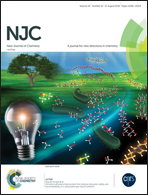Photo-switchable nanoporous silica supports for controlled drug delivery†
Abstract
A photo-responsive ligand 7-[(3-triethoxysilyl)propoxy]coumarin (C) was grafted on the surface of a mesoporous silica SBA-12 material. The obtained functionalized support SBA-12_C was used as an effective light-controlled storage/release system of the anti-inflammatory drug naproxen. Irradiation with UV light at 365 nm induces the photo-dimerization of the coumarin on the surface, giving a dimer connected by a cyclobutane ring, leading to pore closure. However, irradiation with UV light of a shorter wavelength, 254 nm, leads to the cleavage of the dimers, opening of the pores, and the guest drug molecules can be released from the pores. The release of the drug was studied in two types of media, a simulated body fluid at pH = 7 and a simulated gastric fluid at pH = 2. The prepared materials were characterized by high resolution transmission electron microscopy (HR-TEM), nitrogen adsorption/desorption, infrared spectroscopy (FT-IR), thermoanalytical methods (TG/DTA) and liquid and solid-state NMR spectroscopy. The amount of released drug was monitored by HPLC chromatography at defined time intervals. The samples with pores closed by coumarin dimers were tight enough to show premature release of the drug from the sample. After light-driven pore opening, the amounts of released naproxen from coumarin modified mesoporous silica were different, depending on the pH conditions of the release media.



 Please wait while we load your content...
Please wait while we load your content...